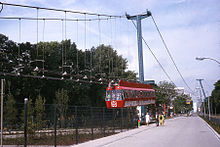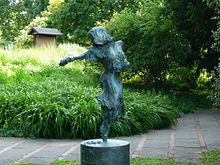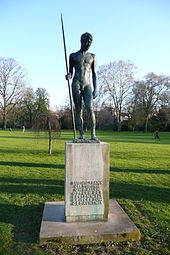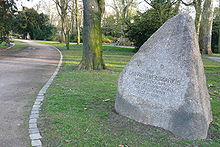Luisenpark Mannheim

The Luisenpark is the largest park in Mannheim . It is located on the left bank of the Neckar , close to the city in the area of a former Neckar loop and is now divided into two parts: The Lower Luisenpark is the oldest part, open to the public and is a garden monument . The Obere Luisenpark is used privately. The operating company, Stadtpark Mannheim gGmbH, advertises the chargeable leisure activities with the slogan: “One of the most beautiful parks in Europe”.
history
At the end of the 19th century, the old boundaries of Mannheim's inner city became too narrow for the growing population, so that the city was to be expanded to the east. In 1872 the city announced a competition for a development plan for the new eastern city . The plan of Karlsruhe's senior building officer Reinhard Baumeister already provided for an elongated park along the Neckar. An important foundation for the park was the legacy of the natural scientist Carl Wilhelm Casimir Fuchs , who bequeathed 20,000 gold marks to the city of Mannheim in his will - earmarked for the construction of a new park .
In 1890 the development plan was approved, which was based on the design from 1872. From the end of 1892, the first part of the park, today the Untere Luisenpark, was built on 10 hectares. It was created by the Frankfurt company Gebrüder Siesmayer, under the direction of Philipp Siesmayer . The design came from his father, the Royal Prussian Horticultural Director and horticultural artist Heinrich Siesmayer , who also designed the Frankfurt Palm Garden . In 1896, the Mannheimers named the park after Luise , the Grand Duchess of Baden , daughter of Kaiser Wilhelm I and wife of Friedrich I of Baden .
In 1897, the park began to be expanded by another 20 hectares, which is now the Obere Luisenpark. In 1906 the city nursery moved to the east of the park. The following year, the city of Mannheim celebrated the 300th anniversary of being awarded city rights. At the horticultural exhibition held in the Augustaanlage , a palm house was very popular with visitors. After the exhibition, a palm house was built in 1908/09 in the upper Luisenpark near the city nursery, which was 42.50 meters long and 16 meters wide.
In the 1920s, the Kutzerweiher was created in the Upper Luisenpark. A sports field followed in the eastern area of the Lower Luisenpark, and in 1927 the planetarium was one of the first in the world. The space pioneers Fritz Haber and Heinz Haber , who grew up nearby, got the inspiration for their later profession there. Both the planetarium and the palm hall were destroyed in the Second World War. The new plant show house, more than twice the size of the old one and this time built in the park near the Kutzerweiher, opened in 1958.
The prerequisite for the rise of the Luisenpark to supra-regional importance was the decision of the Mannheim City Council on November 18, 1969 to hold the National Garden Show in 1975 and to expand the Luisenpark and the Herzogenriedpark . In addition, the park was expanded to a total of 41 hectares by including a former horse racing track. If the Obere Luisenpark was once laid out as a forest park, it has now been completely redesigned by landscape architects. It was important to preserve the old trees, but generously laid out lawns and flower beds. The most important attractions included the new Kutzerweiher with the gondolettas, a mountain stream, the enlargement of the plant show house and the lake stage . During the Federal Horticultural Show, the Aerobus , a suspension railway, connected the Herzogenriedpark with the Luisenpark. An editor of the WDR described the Luisenpark back then as “one of the most beautiful parks in Europe”, which the Stadtparkgesellschaft later adopted as a slogan.
The sale of 186,000 season tickets and the number of 8.1 million visitors, as well as the express wish of the interested population to have the Luisenpark fenced in, convinced the city leaders to continue operating the Luisenpark as a city park with an entrance fee. When the Mannheimer Morgen called for a vote, over sixteen thousand citizens took part. On October 21, 1975 the decision was made for a closed Luisenpark with an entrance fee. At first they agreed on two trial years, but over 38,000 annual tickets sold were a convincing argument to keep the park in this form. This number of season tickets was not even reached by all federal garden shows. For the city's 400th anniversary in 2007, there were considerations to hold another federal horticultural show. However, the existing parks could not have been used for this, or most of them would have had to be redesigned. Therefore, the municipal council waived in 1995.
Even after the National Garden Show in 1975, the part of the Upper Luisenpark that remained closed was carefully maintained and new attractions were regularly opened, such as the Baumhain festival hall, the opening of the sculpture path, the citrus garden, the medicinal plant garden, the butterfly house and the Chinese garden. In 2009 the main entrance of the Luisenpark was completely rebuilt. In the two-storey building there are luggage drop-off facilities, PC terminals for information about the park, lounges, a roof terrace and a souvenir shop.
Upper Luisenpark
The Obere Luisenpark is the largest and most popular park in Mannheim. The attractive park area also attracts numerous visitors from across the region. More than a million people visit the park every year. An extensive network of paths with a length of ten kilometers runs through the park. There are more than 3000 trees of 130 different species, supplemented by more than 100 shrub species. A changing sea of flowers is created with 300,000 flowers in spring and 200,000 summer and autumn flowers annually. Animals can be seen in the farm, in the underwater world, in the terrariums, the bird aviaries, the wading bird meadow and the butterfly house.
Leisure facilities include playgrounds, barbecue areas, mini golf and a large recreational meadow. There is also a rich program of events with exhibitions, theater performances, dance, concerts, children's events and church services. The highlights are the park festivals with fireworks.
Kutzerweiher
The Kutzerweiher was laid out in the 1920s. His name is reminiscent of the former mayor Theodor Kutzer . For the National Garden Show in 1975, the lake was enlarged to 36,300 square meters and a 2,700 meter long shoreline. Today it extends in the west almost to the Untere Luisenpark, two side arms enclose the leisure meadow in the east. An artificially created mountain stream flows into the north-eastern arm. Three wooden bridges and the adventurous jungle bridges make it possible to cross the lake at narrow points.
Ride on the Kutzerweiher Gondo lettas on a 1,840-meter circuit. There are boarding options at two landing stages at the telecommunications tower and at the plant showroom. The 1,500 square meter bird island houses an open-air enclosure with flamingos and cormorants.
Floating stage
The lake stage, built in 1974, lies on the calm waters of the Kutzerweiher in the heart of the Luisenpark. The rising spectator tiers ensure an optimal view of the central stage area and excellent acoustics on each of the almost 1,000 seats, almost half of which are protected from the sun under the bright, characteristic tent roof. The floating stage was built for the Federal Horticultural Show in 1975 as a platform for a festive, cultural program. Dancing teas, theater performances, sports performances and happy children's afternoons all find a suitable setting here.
In 2006 the first season of the new series of Seebühnenzauber events began. Since then, top-class regional, national and international artists have been performing for ten summer evenings from June to August. Stars like Bülent Ceylan , Peter Steiner and Milva have already appeared.
Chinese garden
The garden of many views with the Chinese teahouse in cooperation with Mannheim's Chinese 2001 twin city Zhenjiang , the Klaus Tschira Foundation and the city of Mannheim created. The construction of the garden with tea house was made possible by the inheritance of 1.77 million DM left by the merchant Georg Schmuck, which served as the basis for financing the project. Following the tradition of garden art in China , the Chinese garden and landscape architect Li Zheng planned a Chinese garden based on the model of the private gardens in southern China with the greatest possible authenticity. The Chinese tea house is considered to be the largest tea house in Europe.
Gardens
There are several themed gardens in the park. In heather garden blooming heather and Erika plants . The citrus garden was opened in 2001. 150 plant species from southern countries grow here, including lime , mandarins , bergamot , satsumas and calamondin . The fern garden with 150 species of fern was created in 2005. 2007 saw the opening of the 1,700 square meter medicinal plant garden. The 180 species are planted thematically according to the various indications . The iris garden is located by the mountain stream. The full bloom develops in June.
The perennial garden is arranged symmetrically around the sculpture “Hairwashers” by Martin Mayer . Asters bloom here in summer and autumn. In the grass beds types such as Japanese blood grass , reed grass and giant reed cultivated. There has been a show vineyard since 2004 . The rose promenade leads along the large recreational meadow , where wild roses and cultivars, climbing and bed roses grow. In addition, there are 13 interchangeable flower beds, which are planted differently from year to year.
Plant show house
The plant show house with its 2,700 square meters has stood on the site of the palm house that was destroyed in the Second World War since 1958 . It was expanded in 1975, 1986, 1989 and 1996. Two halls house tropical and subtropical plants such as coffee and rubber trees, giant bamboo and orchids. The tree fern house opened in 2009. Around 400 different types of cacti and 250 succulents grow in the desert climate of the cactus house .
The butterfly paradise has been a special attraction since 1996. Hundreds of free-flying butterflies can be seen here in all stages of development. The underwater world has 33 freshwater and nine saltwater aquariums with freshwater rays , piranhas , electric eels , lionfish and orange ring anemonefish . Turtles , snakes , geckos and iguanas live in the terrarium . There are also aviaries and a monkey enclosure .
Animals
Animals are also kept outside the plant show house. In the farm chickens, pigs, goats, sheep and horses live. There is an owl enclosure at the Baumhain festival hall . In other aviaries you can find bearded birds , beos , bald ibis or yellow and black macaws . The penguin enclosure in which Humboldt penguins live was expanded in 1996. The lesser flamingo , saddle stork , crowned crane and marabou live on the wading bird meadow, an outdoor enclosure .
The mascot of the Luisenpark is the white stork . In 1985 the first pair of storks settled in the park. Targeted support increased the population to 30 pairs of storks, the largest stork colony in a major German city. Over time, more than 900 storks hatched.
game
The recreational meadow on the site of the original racecourse has a size of 80,000 square meters. For children there are play facilities such as a ramp maze, a cable car and a trampoline . The leisure center offers events for all age groups. In addition, there are six playgrounds in the Luisenpark , including a castle and a water playground, a mini car and mini golf course.
Sound oasis
The sound oasis was opened in 1996 in a clearing. Instrumental music by Peter Seiler streams from several speakers in the trees . Visitors can relax here on deck chairs.

Heinrich-Vetter-Weg
The Heinrich-Vetter-Weg is a sculpture path with works of art by renowned sculptors. It was created in 1992 through donations from the Mannheim honorary citizen Heinrich Vetter . More than twenty sculptures by artists such as Amadeo Gabino , Kubach-Wilmsen and Ben Muthofer are displayed here.
Telecommunications tower
The Luisenpark is dominated by the telecommunications tower built in 1975. It is 217.8 meters high and has a viewing platform at a height of 120 meters and above it at a height of 125 meters a revolving restaurant that rotates around its own axis once an hour. The telecommunications tower is outside the Luisenpark, but in the immediate vicinity of the northern entrance named after the telecommunications tower.
Lower Luisenpark


The Lower Luisenpark has great historical horticultural importance and is a garden monument from the end of the 19th century. In contrast to the upper part, it is freely accessible and is therefore used in a variety of ways. The trapezoidal area was the first part of the two park areas, which is designed in the style of an English landscape park. Originally there was a roundabout with a water fountain, which has not been preserved.
A memorial stone commemorates Carl Wilhelm Casimir Fuchs , which was erected out of gratitude because Professor Fuchs initiated the design of the park and also bequeathed a large part of his estate to finance the city. Of the old planetarium , one of the first in the world, only the hill can be seen. Heinz Haber was the initiator of a reconstruction at this point and had corresponding plans made, which are now in the Mannheim architecture and construction archive of the Mannheim City Archives . With his brother Fritz , he found inspiration for a career in space research near his parents' house . In 1924 a memorial was erected for Ludwig Frank , a member of the Mannheim Reichstag who fell in World War I and was removed by the National Socialists. In 1950 a new sculpture, “Young Man with a Staff”, was erected in memory of Ludwig Frank and the victims of the First World War.
For the Federal Garden Show in 1975, the path boundaries were made with historic blue basalt stones from former cobblestones. Due to a private initiative from 2007 to 2009, the memorial stone for Professor Fuchs was cleaned and the overgrown path boundaries between Kolpingstrasse and Bassermannstrasse were restored to their old condition. Afterwards, the specialist department for green spaces restored the design language of the edges of the paths in a path renovation concept in 2010, thereby recognizing their importance as a garden monument.
On the eastern side is a public sports field with a running track and kiosk. It is used during the day for school sports and afterwards, especially on weekends, for recreational sports. The children's playground invites parents with their children without paying a parking fee. The park offers exercise and relaxation close to nature to the nearby hospital and retirement home.
literature
- Stadtpark Mannheim (Hrsg.): Luisenpark Mannheim: Parkführer . Mannheim 2008.
- Gerd-Niels Wötzel, Karl Eisenhuth, Joachim Költsch: Luisenpark Mannheim: One of the most beautiful parks in Europe . Mannheim 1997.
- City archive Mannheim , Mannheimer Architektur- und Bauarchiv eV (ed.), Andreas Schenk: Mannheim and its buildings 1907–2007: Volume 5 . Mannheim 2005, ISBN 3-923003-89-7 .
- Klaus ER Lindemann: A festival changes the city . Mannheim 1975.
Web links
- Luisenpark
- Luisenpark Seebühnenzauber
- Luisenpark sponsorship group
- Chinese Garden Sponsorship Association
- Sights in Mannheim
Individual evidence
- ↑ MARCHIVUM: Chronicle star . November 1, 1892, Retrieved September 27, 2018 .
- ↑ Mannheimer Morgen, July 23, 2011 ( page no longer available , search in web archives ) Info: The link was automatically marked as defective. Please check the link according to the instructions and then remove this notice.
- ↑ Rhein-Neckar-Zeitung March 6, 2009 ( page no longer available , search in web archives ) Info: The link was automatically marked as defective. Please check the link according to the instructions and then remove this notice.
- ↑ Seebühnenzauber im Luisenpark , website of the organizer
- ↑ From his parents' house in Bassermannstr. 55, passed in 1978.
Coordinates: 49 ° 28 ′ 57.7 " N , 8 ° 29 ′ 50.6" E







